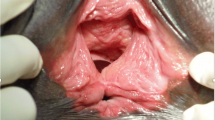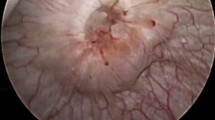Abstract
Children with nasolacrimal duct obstruction (NLDO) have different therapeutic approach from that used in adults. Dacryocystorhinostomy (DCR) is the most common procedure in adults but it is less frequently carried out in children, indicated in children which are refractory to probing. The objective of the study is to report a series of 30 cases of paediatric epiphora who underwent endoscopic endonasal dacryocystorhinostomy surgery, for primary obstruction of nasolacrimal duct and results, outcomes of success are evaluated. This is a prospective and non-comparative review of 30 cases of epiphora aged between 3 and 9 years from April 2018 to March 2019. The main outcome measures assessed were determined by the resolution of symptoms and the patency of the lacrimal anatomy confirmed by syringing or irrigating the nasolacrimal duct. Secondary outcomes included the presence of such complications as bleeding, scarring, and/or persistent epiphora and infection. In our study 30 patients underwent unilateral DCR surgery in NLDO. Out of 30 patients males were 17 and females were 13. The overall success rate of endoscopic DCR was 90%, and failed cases were mainly due to pre-saccal obstruction. No major complications were reported, minor complications occurred in about 60% of cases. Analysis of the results indicated that EDCR was safe and an effective therapeutic approach for treating nasolacrimal duct obstruction in pediatric age group patients having NLDO. It’s considered as an alternative procedure to external dacryocystorhinostomy after a failed conservative treatment.
Similar content being viewed by others
Availability of data and material
Pro-forma of the data taken is filled for every patient and is available with the first author for review.
Code availability
Not applicable (no special Software used).
References
MacEwen CJ, Young JD (1991) Epiphora during the first year of life. Eye (London) 5:596–600
Sihota R, Tandon R (2011) Disease of lacrimal apparatus. Parson’s disease of eye. Elsevier, Amsterdam
Komínek P, Červenka S (2005) Pediatric endonasal dacryocystorhinostomy: a report of 34 cases. The Laryngoscope 115(10):1800–1803
Freitag SK, Woog JJ (2000) Congenital nasolacrimal obstruction. Ophthalmol Clin 13(4):705–718
Gupta AK, Bansal S (2006) Primary endoscopic dacryocystorhinostomy in children: analysis of 18 patients. Int J Pediatr Otorhinolaryngol 70:1213–1217
Cunningham MJ (2008) Endoscopic management of pediatric nasolacrimal Anomalies. Oper Tech Otorhinolaryngol 19:186–191
Sonkhya N, Mishra P (2009) Endoscopic transnasal dacryocystorhinostomy with nasal mucosal and posterior lacrimal sac flap. J Laryngol Otol 123(3):320–326
Komínek P, Cervenka S (2005) Pediatric endonasal dacryocystorhinostomy: a report of 34 cases. Laryngoscope 115(10):1800–1803. https://doi.org/10.1097/01.mlg.0000175678.73264.88
Berlucchi M, Staurenghi G, Rossi Brunori P, Tomenzoli D, Nicolai P (2003) Transnasal endoscopic dacryocystorhinostomy for the treatment of lacrimal pathway stenoses in pediatric patients. Int J Pediatr Otorhinolaryngol 67(10):1069–1074
Woog JJ, Kennedy RH, Custer PL et al (2001) Endonasal dacryocystorhinostomy: a report by the American Academy of Ophthalmology. Ophthalmology 108:2369–2377
Hartikainen J, Antila J, Varpula M et al (1998) Prospective randomised comparison of endonasal endoscopic dacryocystorhinostomy and external dacryocystorhinostomy. Laryngoscope 108:1861–1866
Jones DT, Fajardo NF, Petersen RA et al (2007) Pediatric endoscopic dacryocystorhinostomy failures: who and why? Laryngoscope 117:323–327
Komínek P, Cervenka S, Matousek P, Pniak T, Zeleník K (2010) Primary pediatric endonasal dacryocystorhinostomy—a review of 58 procedures. Int J Pediatr Otorhinolaryngol 74(6):661–664. https://doi.org/10.1016/j.ijporl.2010.03.015
Cunningham MJ, Woog JJ (1998) Endonasal endoscopic dacryocystorhinostomy in children. Arch Otolaryngol Head Neck Surg 124(3):328–333
Vanderveen DK, Jones DT, Tan H, Petersen RA (2001) Endoscopic dacryocystorhinostomy in children. J AAPOS 5(3):143–147. https://doi.org/10.1067/mpa.2001.114910
Eloy P, Leruth E, Cailliau A, Collet S, Bertrand B, Rombaux P (2009) Pediatric endonasal endoscopic dacryocystorhinostomy. Int J Pediatr Otorhinolaryngol 73(6):867–871. https://doi.org/10.1016/j.ijporl.2009.03.006
Moss SE, Klein R, Klein BE (2000) Prevalence and risk factors for dry eye syndrome. Arch Ophtalmol 118:1264–1268
McDonogh M, Meiring JH (1989) Endoscopic transnasal dacryocystorhinostomy. J Laryngol Otol 103:585–587
Bernal Sprekelsen M, Massegur H, Tomas M (2003) Endoscopic sinus surgery in children. Rev Laryngol Otol Rhinol 124:245–250
Marfatia H, Shah K, Patil S, Parmar Y (2017) Endonasal dacryocystorhinostomy in children: our experience. Int J Surg. 47:91–95. https://doi.org/10.1016/j.ijsu.2017.09.064.-0273-y
Funding
NIL (Research was done in JLN Medical College and was ethically approved by Ethical Committee of JLN Medical College).
Author information
Authors and Affiliations
Corresponding author
Ethics declarations
Conflicts of interest
Authors involved in this trial have no conflict of interest.
Research involving Human Participants
The Trial was approved from ethical point of view by Ethical Committee of JLN Medical College, Ajmer, Rajasthan.
Informed consent
Written-Informed consent taken from all patients in native language.
Additional information
Publisher's Note
Springer Nature remains neutral with regard to jurisdictional claims in published maps and institutional affiliations.
Rights and permissions
About this article
Cite this article
Poonia, R., Aseri, Y., Rawat, D.S. et al. A Prospective Longitudinal Study to Evaluate the Outcomes of Success of Endoscopic DCR in Pediatric Age Group. Indian J Otolaryngol Head Neck Surg 74, 18–22 (2022). https://doi.org/10.1007/s12070-020-02109-z
Received:
Accepted:
Published:
Issue Date:
DOI: https://doi.org/10.1007/s12070-020-02109-z




